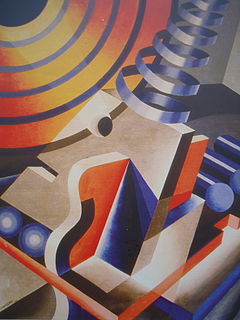- Nikolay Diulgheroff
-
Nikolay Diulgheroff[1] (Bulgarian: Николай Дюлгеров, Nikolay Dyulgerov; 20 December 1901–9 June 1982) was a Bulgarian artist, designer and architect who was active in Italy as a prominent representative of interwar Italian Futurism (il secondo Futurismo).
Biography
Diulgheroff was born in Kyustendil, a town in the western part of the Principality of Bulgaria, to a printer father. In 1920 and 1921, he studied at the University of Applied Arts in Vienna, Austria. The following year he studied in Dresden, Germany, and in 1923 he enrolled at the original Bauhaus in Weimar,[2][3] where he was close to Swiss expressionist Johannes Itten. While a student in Germany, Diulgheroff exhibited his art in Berlin and Dresden. In 1924, he had his separate exhibition in Sofia, the capital of Bulgaria.[2][3]
In 1926, Diulgheroff settled in Turin, Italy, to study architecture at the Accademia Albertina, graduating in 1932. Bringing with him a characteristically Central European constructivist culture, he was introduced to many of the eminent Italian futurists, such as Fillia, and adopted that style.[4] Diulgheroff created his most notable works in the 1920s and 1930s. Some of his art is exhibited in the Galleria Nazionale d'Arte Moderna in Rome. He contributed to the Futurist meals formulated in Filippo Tommaso Marinetti and Fillia's 1930 Manifesto of Futurist Cooking: the dish pollofiat was his idea and he co-designed the interior of the Taverna Santopalato, the prime establishment for futurist cuisine.[5] He created posters for Cinzano and Amaro Cora[2][3] and advertising for Campari.[6] Diulgheroff was part of leading futurist exhibitions throughout the 1920s and 1930s, such as those in Turin, Leipzig, Paris, Florence, Barcelona, Mantua and Venice.[7]
Diulgheroff died in Turin, the city where he spent 56 years, in 1982. Diulgheroff remained active as an artist almost until his death.[3] He is an honorary citizen of Turin[8] and art historian Enrico Crispolti considers him the greatest of all interwar artists.[9]
References
- ^ First name also spelled Nicola, Nikola, Nicolay, Nicolaj, Nikolaj, etc.
- ^ a b c "Nikolay Diulgheroff — L’Identità Artistica Multiforme" (in Italian). Politecnico di Torino. 2009. http://www.polito.it/php/news/index.php?idn=2483&lang=it. Retrieved 2009-08-28.
- ^ a b c d ди Дженова, Джорджо (2001-06-22). "Николай Дюлгеров — българско-торински футурист" (in Bulgarian). Cult.bg. http://www.cult.bg/ind_varts_hist_full.php?id=104. Retrieved 2009-08-28.
- ^ "На 27 май от 17.00 ч. в почетния салон на замъка на Валентино в Торино се проведе конференция за творчеството на големия български художник-футурист Николай Дюлгеров" (in Bulgarian). Министерство на културата на Република България. http://mc.government.bg/print.php?p=393. Retrieved 2009-08-28.
- ^ "Santopalato, Lista del Primo Pranzo Futurista" (in Italian). Primo pranzo futurista. http://www.pungitopo.com/caffe/futurismo.html. Retrieved 2009-08-28.
- ^ "Albisola Futurista: La grande stagione degli Anni Venti e Trenta" (in Italian). Fabrizia Buzio Negri e Riccardo Zelatore. 2003. http://www.buzionegri.it/mostre_arte/albisola%20futurista.doc. Retrieved 2009-08-28.
- ^ "NICOLAJ DIULGHEROFF ( Kiustendil 1901 – Torino 1982)" (in Italian). '900. Cento anni di creatività in Piemonte. http://www.novecentopiemontese.it/didattica/15.html. Retrieved 2009-08-28.
- ^ "Изложба "Николай Дюлгеров. Множествената художествена идентичност"" (in Bulgarian). Нов български университет. http://www.nbu.bg/PUBLIC/IMAGES/File/departments/history%20of%20culture/events/Press_release%5B2%5D.pdf. Retrieved 2009-08-28.
- ^ Георгиева, Емилия (2002). "Забравен или незабравим. Изкуството на Николай Дюлгеров (1901-1982)" (in Bulgarian). България Днес. ISSN 2196 1311 2196. http://www.aba.government.bg/bg/Bd/Archive/192002/palitra1.htm. Retrieved 2009-08-28.[dead link]
Categories:- Bulgarian painters
- Bulgarian designers
- Bulgarian architects
- Italian painters
- Italian designers
- Italian architects
- Futurist painters
- Futurist architects
- 1901 births
- 1982 deaths
- People from Kyustendil
- Bauhaus
Wikimedia Foundation. 2010.

